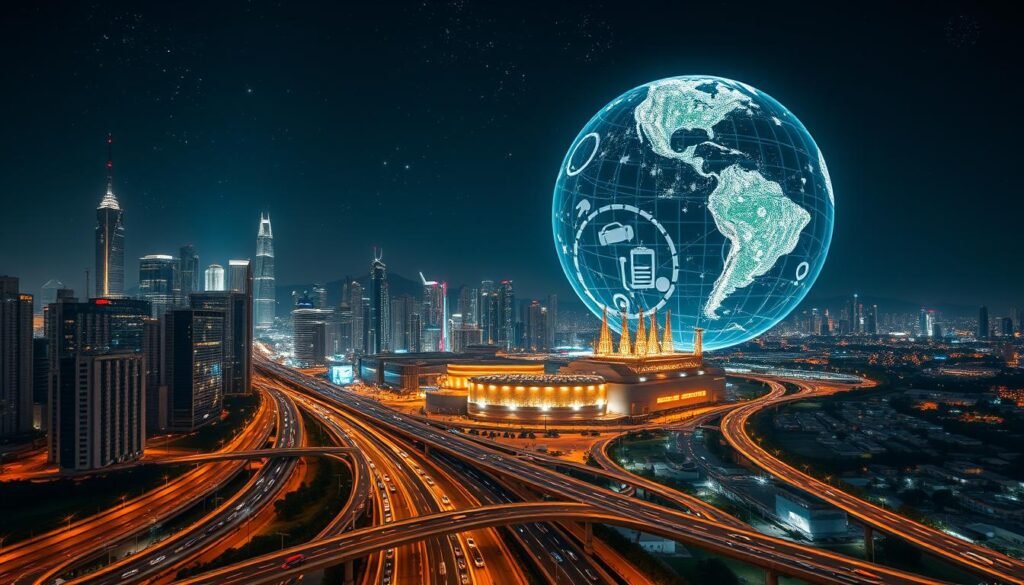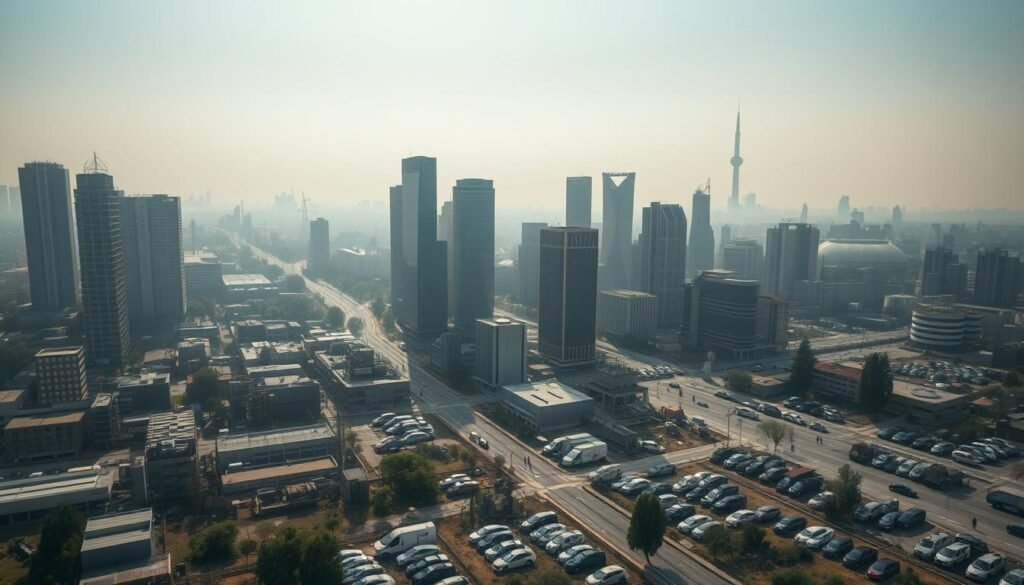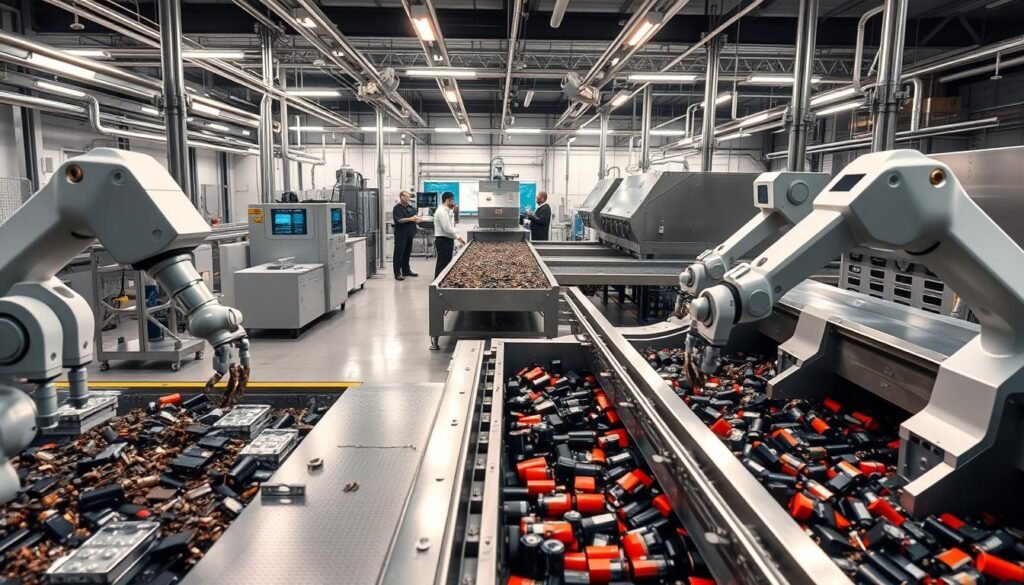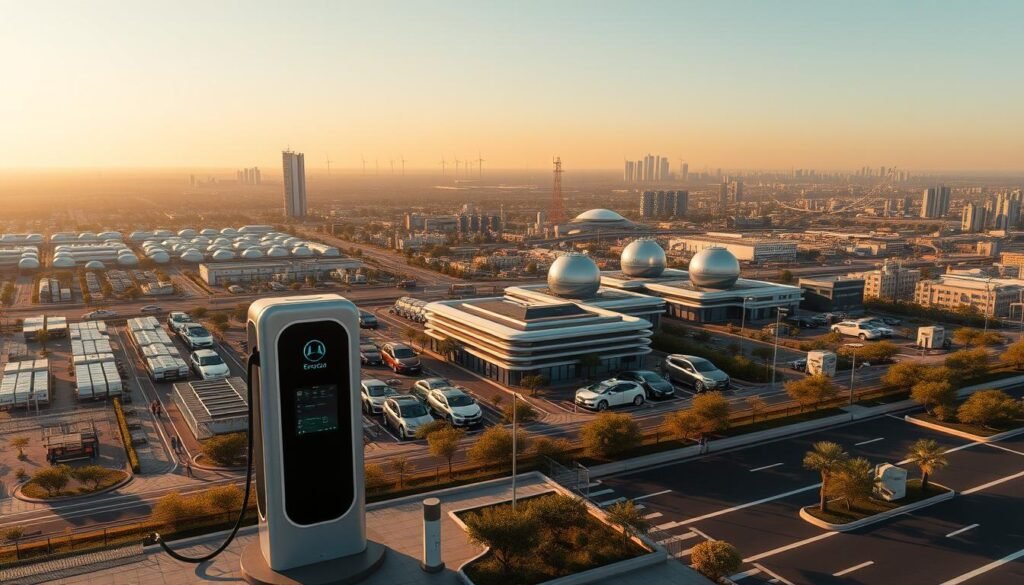Did you know that the electric vehicle battery shortage could affect nearly 8 million EVs worldwide by 2025? This shows how big the challenge is in making our transportation green. As more people want electric cars, we’re facing big problems getting the needed materials like lithium and cobalt.
These issues not only raise prices but also slow down how many cars we can make. It’s important to understand these problems to see how they affect the whole industry and our future of getting around.
Overview of Electric Vehicle Battery Technology
The world of electric vehicle (EV) battery tech is always changing. This is thanks to new ideas and the need for green solutions. Knowing about the different EV batteries is key to understanding the field’s progress. It helps people choose the right electric car for them.
Types of Electric Vehicle Batteries
There are several types of EV batteries out there. The most common ones are:
- Lithium-ion Batteries: These batteries are known for their high energy and efficiency. They’re used in most electric cars today.
- Nickel-Metal Hydride Batteries: Though not as common, they’re good for performance and last long. They’re mainly found in hybrid cars.
- Solid-State Batteries: This new tech promises better safety and energy. It could change what we expect from EV batteries.
Key Players in Battery Manufacturing
Big names in battery making are key to battery technology advancements. The top players are:
- Tesla: Known for its innovation, Tesla keeps improving battery capacity and efficiency.
- CATL: This Chinese company is a big name in lithium-ion batteries. They focus on making lots and improving them.
- Panasonic: A long-time partner with Tesla, Panasonic is known for making reliable batteries.
Partnerships between car makers and tech companies are bringing new ideas to battery making. As we move towards a fully electric future, these partnerships are exciting for everyone involved.
Causes of the Current Battery Shortage
The electric vehicle (EV) market is facing big challenges due to a battery shortage. This shortage is caused by supply chain disruptions, rising demand for EV batteries, and geopolitical issues affecting battery supply.
Supply Chain Disruptions
The COVID-19 pandemic has shown the weaknesses in global supply chains. Manufacturers and logistics providers found it hard to keep up, leading to delays and shortages. Transportation problems and factory closures made it tough to meet EV industry demands.
The effects of these supply chain issues were felt across all sectors needing batteries. It highlighted the need for timely and enough battery supplies.
Increased Global Demand
The demand for EV batteries has skyrocketed, thanks to climate efforts and people wanting green transport. This surge has made manufacturers compete fiercely for resources. Governments’ goals to cut carbon emissions have made electric vehicles even more important.
This growing demand for EV batteries has put a lot of pressure on available resources. It has made the shortage even more severe.
Geopolitical Factors Affecting Supply
Geopolitical issues are also key in the battery supply chain. Trade disputes and mining rules in places like the Democratic Republic of Congo add to the problem. These issues make it hard for manufacturers to get the materials they need.
They have to deal with economic and political factors affecting resource availability. Finding a balance is critical as the EV market grows.

Impact of the Battery Shortage on Electric Vehicle Sales
The battery shortage has shaken the electric vehicle (EV) sales scene, mainly in India. Despite the market’s growth, inventory issues are a big problem. This part talks about how the shortage affects EV sales and the challenges for makers and dealers.
Sales Trends in the Indian Market
Electric vehicle sales in India have seen ups and downs, mainly because of the battery shortage. Even though more people want green cars, the battery shortage stops makers from meeting demand. A recent study showed a 15% drop in EV sales last quarter because of supply chain problems.
This shortage makes it hard for makers and buyers to plan. It shows how big the shortage’s impact is on EV sales. Everyone involved is trying to adjust to this new situation.
Effects on Manufacturers and Dealerships
Manufacturers and dealers are dealing with the battery shortage’s effects. Makers face high costs and the need for affordable electric cars. Dealers need to plan their stock better, which changes their sales forecasts.
As people’s trust in electric cars wavers, they buy less. This cautious buying affects sales now and shapes the market’s future. It’s a big challenge for everyone involved.
| Quarter | EV Sales (Units) | Percentage Change |
|---|---|---|
| Q1 2022 | 12,000 | – |
| Q2 2022 | 10,200 | -15% |
| Q3 2022 | 11,500 | +13% |
| Q4 2022 | 10,200 | -15% |
| Q1 2023 | 11,000 | -4% |
Economic Implications of the Battery Shortage
The battery shortage has big economic effects on the electric vehicle (EV) market. A main worry is the rising prices of EVs due to higher costs for key materials like lithium and cobalt. Because of supply chain problems, makers struggle to meet demand. This leads to higher prices for EVs, impacting both buyers and the industry.
Price Increases for Electric Vehicles
The battery shortage’s economic impact is clear in EV prices going up. Big car makers face higher costs for raw materials needed for better batteries. They often raise prices for consumers as a result. In the past year, EV prices have jumped by over 10%, mainly because of lithium and cobalt price changes.
Impact on Investments in Battery Technology
The battery shortage has also changed where companies invest in EV tech. More money is going into research for new battery types. EV makers are working to make more batteries and find better solutions. They aim to keep the market stable and ensure the industry’s future.

Regional Variations in Battery Shortages
Looking at battery supply challenges, we notice big differences around the world. Countries like India face unique challenges. These differences affect how electric vehicles are adopted globally.
India’s situation helps us understand both similarities and differences with other countries. This knowledge is key to solving battery supply issues worldwide.
The Situation in India
India has big battery supply problems. These come from local production, government policies, and market needs. Despite wanting more electric vehicles, India relies on imported batteries.
This reliance affects both availability and price. It creates big hurdles for makers and buyers. The Indian government aims for greener transport, but the path is tough.
Comparison with Global Trends
India’s battery issues are not alone. Countries like China and Europe have made progress. They have better battery production and supply chains.
These countries have advanced tech and support. India, on the other hand, is just starting. It needs new ways to boost local making and connect with global markets.
Strategies to Mitigate Battery Shortages
The demand for electric vehicles is growing fast. This makes the battery shortage problem more urgent. We need to find new ways to solve this. Two key strategies are improving battery recycling and creating new EV battery types.
Both methods aim to use resources better and make the industry more sustainable.
Innovation in Battery Recycling
Battery recycling is changing how we use resources. New processes let us get valuable materials from old batteries. This means we don’t need as many new raw materials.
This approach helps the environment a lot. It makes us use resources more wisely. Companies are working on better recycling methods.
These efforts help reduce waste and solve the shortage problem. They also show the importance of recycling batteries properly.
Alternative Battery Technologies
New battery types like sodium-ion or solid-state batteries are being explored. They use common materials, easing the supply chain pressure. These batteries could be safer and more efficient.
Researchers and makers are focusing on these new options. They have the chance to change the battery world soon.

Role of Government Policies in Addressing Shortages
Government policies are key in solving the battery shortage crisis in the electric vehicle (EV) market. They can greatly help the industry grow and stay sustainable. This includes using incentives and setting rules. Knowing about these can show how government actions can make a big difference.
Incentives for Electric Vehicle Adoption
Government incentives for EVs are vital to get more people interested in electric cars. Things like rebates, tax breaks, and grants make EVs more affordable. These programs help sell more EVs and make manufacturers more willing to produce more.
In places like India, these incentives help move towards cleaner transport. They help meet goals for sustainable development.
Regulatory Framework for Battery Manufacturing
Rules for making batteries set the standards for how they are made. These rules make sure production is both efficient and good for the environment. Following these rules helps avoid problems with getting materials, promotes recycling, and supports green tech.
Strong rules from governments can make the supply chain more reliable. This makes battery production in the EV industry more stable and long-lasting.
| Policy Type | Description | Impact |
|---|---|---|
| Subsidies | Financial incentives provided to consumers for purchasing EVs. | Increased sales, market penetration. |
| Tax Rebates | Reductions in taxes for EV buyers and manufacturers. | Lowered initial costs, boosted production. |
| Environmental Regulations | Standards concerning the ecological footprint of battery production. | Promotion of sustainable manufacturing practices. |
| Research Grants | Funding for innovative battery technologies and recycling methods. | Enhanced R&D, technological advancement. |
The Future Outlook for Electric Vehicle Batteries
The future of EV batteries looks bright. We’re seeing more battery production and new technologies. Experts say we’ll see a big jump in production as electric cars become more popular. This means we’ll see new ways to make batteries better.

Predictions for Battery Production Capacity
Many things will affect how many batteries we can make. Experts think making batteries faster will help a lot. Big car and tech companies are investing in making more batteries.
They’re moving from old lithium-ion batteries to new ones. This could make batteries cheaper and more available.
Emerging Technologies on the Horizon
New battery technologies are coming. Solid-state batteries will charge faster and hold more energy. New types of batteries, like lithium-sulfur and lithium-iron-phosphate, will be lighter and last longer.
These advancements will help electric cars become more common. They’ll solve problems with storing energy and being green.
Consumer Awareness and Education
The electric vehicle market is growing fast. Knowing about EV batteries is key for making smart choices. This knowledge helps us pick the right electric car and supports green living.
Importance of Understanding Battery Technology
Knowing about battery tech is important for electric cars. It lets us compare different models. This knowledge helps us see if electric cars are worth it, both for our wallets and the planet.
Resources for Consumers
There are many places to learn about EV batteries. These resources help us understand and engage with battery tech:
- Online Tutorials: Sites like InsideEVs and Green Car Reports have detailed guides.
- Community Workshops: Local groups and car dealers host workshops on battery care.
- Online Forums: Reddit is a place for sharing battery experiences and tips.
Using these resources, we can learn a lot about batteries. This helps us make better choices and support others in our community.
| Resource Type | Examples | Benefits |
|---|---|---|
| Online Tutorials | InsideEVs, Green Car Reports | Accurate and updated information |
| Community Workshops | Local community centers, dealerships | Hands-on experience and advice |
| Online Forums | Reddit, Quora | Peer support and shared knowledge |
Navigating the Future of Electric Vehicle Batteries
As we finish our look at the electric vehicle battery shortage, it’s clear the issues are complex. We’ve talked about the tech behind these batteries, why we’re facing shortages, and the economic effects. We also highlighted the importance of finding new ways to make batteries for a smooth move to electric cars in India and worldwide.
Our final thoughts stress the need for teamwork. We must push for green battery making. Working together can lead to new, better ways to make batteries. This includes recycling and new tech, which are key for a green future in transport.
In the end, our path to a greener, more efficient electric car world is just starting. By working together, we can tackle today’s problems and build a strong base for tomorrow. This will help us move towards cleaner, fairer transport for everyone.




